Issue 12: Intimate Partner Violence in Rainbow Communities
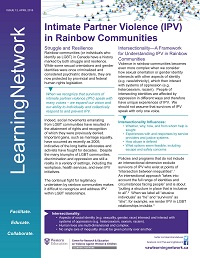 Printable PDF Version
Printable PDF Version
Click here for Plain Text Version
Struggle and Resilience
Rainbow communities (or individuals who identify as LGBT) in Canada have a history marked by both struggle and resilience. While some sexual orientations and gender identities were once criminalized and considered psychiatric disorders, they are now protected by provincial and federal human rights legislation.
When we recognize that survivors of intimate partner violence (IPV) speak with many voices – we expand our vision and our ability to individually and collectively respond to and prevent IPV.
Indeed, social movements emanating from LGBT communities have resulted in the attainment of rights and recognition of which they were previously denied. Important gains, such as marriage equality, have occurred as recently as 2005, indicative of the long battle advocates and activists have fought for decades. Despite the many triumphs of LGBT communities, discrimination and oppression are still a reality in a variety of settings, including the workplace, health services, and even IPV initiatives.
The continual fight for legitimacy undertaken by rainbow communities makes it difficult to recognize and address IPV within LGBT relationships.
Intersectionality—A Framework for Understanding IPV in Rainbow Communities
Violence in rainbow communities becomes even more complex when we consider how sexual orientation or gender identity intersects with other aspects of identity (e.g. race/ethnicity), which then interact with systems of oppression (e.g. heterosexism, racism). People of intersecting identities are affected by oppression in different ways and therefore have unique experiences of IPV. We should not assume that survivors of IPV speak with only one voice.
Intersectionality Influences:
- Whether, why, how, and from whom help is sought
- Experiences with and responses by service providers and justice systems
- How abuse is defined
- What options seem feasible, including escape and safety concerns
Policies and programs that do not include an intersectional dimension exclude survivors of IPV who exist at points of “intersection between inequalities”.1 An intersectional approach “takes into account the full range of identities and circumstances facing people” and is about “putting a structure in place that is inclusive to all”.2 When we label all “abusive individuals” as “he” and “survivors” as “she”, for example, we render IPV in LGBT relationships invisible.3
Intersectionality:
- Aspects of social identity (e.g. sexuality, gender, race) intersect and interact with systems of oppression (e.g. heterosexism, sexism, racism).
- Human lives are multi-dimensional and complex.
- No single axis of inequality should be given priority over another.
Intimate Partner Violence in LGBT Relationships
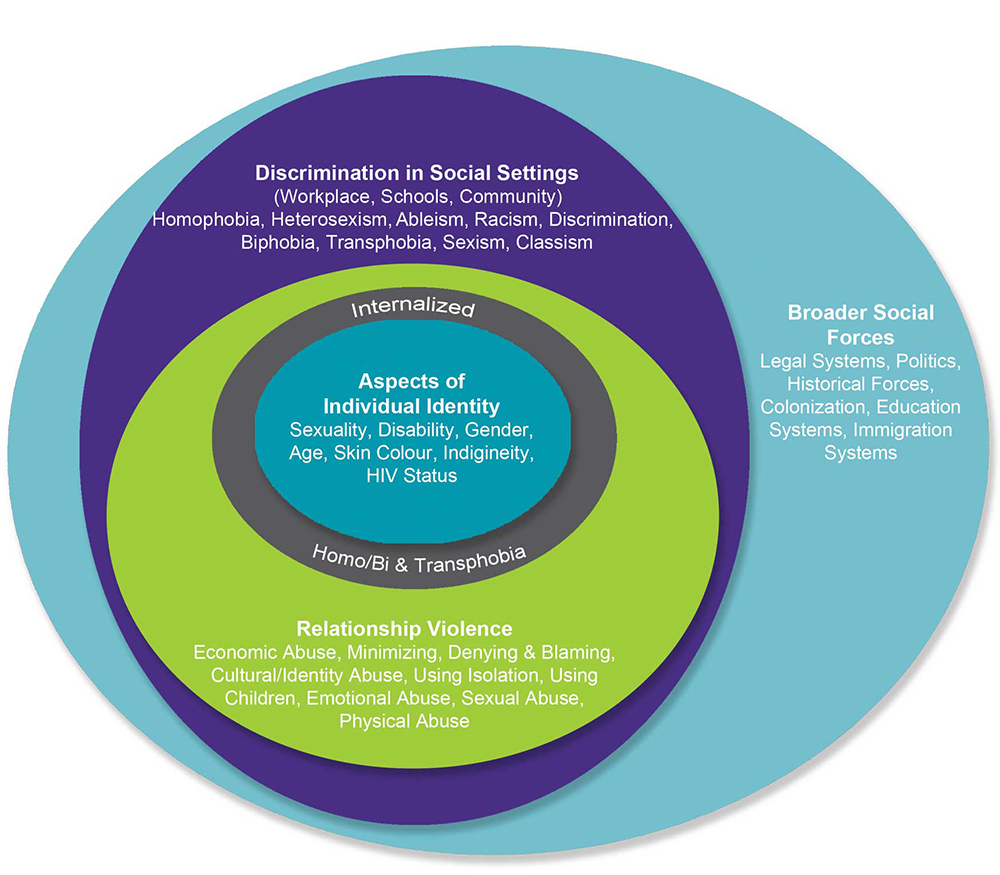
Innermost Circle: Aspects of Individual Identity (Sexuality, Disability, Gender, Age, Skin Colour, Indigineity, HIV Status)
Second Circle: Internalized Homo/Bi & Transphobia
Third Circle: Relationship Violence (Economic Abuse, Minimizing, Denying & Blaming, Cultural/Identity Abuse, Using Isolation, Using Children, Emotional Abuse, Sexual Abuse, Physical Abuse)
Fourth Circle: Discrimination in Social Settings (Workplace, Schools, Community) Homophobia, Heterosexism, Ableism, Racism, Discrimination, Biphobia, Transphobia, Sexism, Classism
Outermost Circle: Broader Social Forces (Legal Systems, Politics, Historical Forces, Colonization, Education Systems, Immigration Systems)
Risk Reduction and Safety Planning
Physical and sexual abuse in LGBT relationships can be lethal.
The pervasive myth that violence in same sex or transgender relationships is “mutual violence” masks the risk posed by some abusive individuals to their partners. Education to remove barriers to services and further research on risk indicators for lethality in the context of LGBT partner violence is needed to ensure that the right approaches and tools are available to save lives. In the meantime, using the risk factors for dangerousness in heterosexual relationships (e.g. access to a weapon, prior threats to kill, prior history of IPV) is a promising practice (see www.cdhpi.ca).
Risk assessment and management, however, must be accompanied by safety planning with the abused partner.
Promising safety plans with LGBT survivors:
- build on the strengths of the LGBT individual (e.g. individual’s “family of choice”),
- build on the strengths of the rainbow community (e.g. resources),
- take into consideration the reality that resources for IPV survivors may be unavailable to LGBT clients, or viewed as not accessible by them (e.g. fears of discrimination may prevent reporting to authorities; lack of shelters for transgender or gay survivors).
For additional information contact the organizations in the Resource section of this newsletter.
Experiences of Intimate Partner Violence
IPV Survivors--including LGBT Survivors--may experience: |
LGBT Survivors may also experience: |
|---|---|
| Emotional Abuse | |
|
|
| Minimizing, Denying or Blaming | |
|
|
| Physical Abuse | |
|
|
| Sexual Abuse | |
|
|
| Cultural/Identity Abuse | |
|
|
| Using Children | |
|
|
| Using Isolation | |
|
|
| Economic Abuse | |
|
|
Barriers to Services
Barriers can relate to perceptions about or the actual practices of service providers
Barriers to Services for LGBT Survivors and Abusive Partners:
- Lack of knowledge of LGBT issues by service providers
- Invisibility – no mention of LGBT partner abuse in outreach materials
- Judgement and homo/bi/transphobia of service providers
- Use of non-inclusive, heteronormative language and practices
- “Outing” LGBT survivors/abusive partners to other program participants or providers
- Allowing staff or other clients to harass LGBT survivors/abusive partners with no consequences
- Refusing services on the basis of gender identity
- Unsafe practices – survivors and abusive partners in the same program
- Inconsistent organizational responses to disclosures by LGBT survivors
- Lack of programs that specialize in IPV services for LGBT survivors and abusive partners
Competencies to Reduce Barriers
Practices: |
Examples Include: |
|---|---|
|
Be aware of your own beliefs and knowledge about LGBT individuals |
Reflect on how your own identities, personal biases, and cultural experiences affect your practice |
|
Listen to LGBT voices and become familiar with LGBT culture |
Attend educational events sponsored by LGBT organizations Build working alliances with LGBT organizations |
|
Challenge homo/bi/transphobia in your agency |
Confront statements and jokes that discriminate or make fun Establish zero indifference to and consequences for LGBT discrimination (e.g. policies, LGBT competence training) |
|
Make it visible that LGBT clients are welcome and belong in your organization |
Include LGBT partner abuse in outreach materials Assess inclusivity of organization (e.g. Positive Spaces Initiative through OCASI) |
|
Use inclusive language |
Use the terms partner or spouse when asking about sexual or abusive partner Approach intake questions in a sensitive, open-ended manner that allows for disclosure of sexual orientation and/or gender identity, experiences of abuse, and trauma |
|
Offer programs that are responsive and accessible to LGBT individuals and families |
Separate group programs for LGBT survivors and abusive partners to reduce impact of heterosexism and homo/bi/transphobia Address violence in LGBT parent relationships in children’s exposure to violence groups |
|
Establish service protocols that promote the safety of both partners in abusive LGBT relationships |
Respect confidentiality and refrain from “outing” client to others without explicit permission |
|
Distinguish abused partner from the abusive partner |
Assess for a dominant aggressor in cases of so called “mutual violence” Do not assume person accompanying LGBT survivor to appointment is not the abusive partner |
|
Establish an empathetic and non-judgmental relationship with LGBT clients |
Recognize that LGBT relationships are valid Refer to clients and their partners with the words and pronouns used by the client |
|
Develop strength-based safety plans |
Build on the strengths of the LGBT individual (e.g. individual’s “family of choice”) as well as the strengths of the rainbow community (e.g. resources) Be aware that resources for IPV survivors may be unavailable to, or viewed as not accessible by, LGBT clients (e.g. shelters for transgender or gay survivors) |
LGBT Organizations and Networks
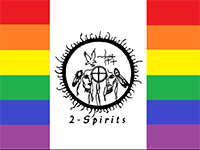 2Spirited People of the First Nations
2Spirited People of the First Nations
This website offers a number of resources, reports and information on aboriginal, LGBTQ and 2-spirited people including information regarding health and domestic violence.
 The 519 Church Street Community Centre
The 519 Church Street Community Centre
This centre in Toronto provides supports and services to LGBT communities, including education and training, sports and recreation, community drop-in, and newcomer settlement services.
 Family Service Toronto David Kelley Services
Family Service Toronto David Kelley Services
This agency provides a range of counselling services to people who identify as LGBTQ. Partner Assault Response Services are provided for court and probation-mandated individuals charged with assault to a same-sex partner.
Egale
A national charity that promotes LGBT human rights through education and research on such topics as safe schools and hate crimes. In Toronto, Egale supports the Egale Youth OUT Reach program which provides crisis intervention, counselling and provides assistance with housing for LGBT youth.
Lesbian Gay Bi Trans Youthline (1-800-268-9688)
A toll-free peer support phone line for lesbian, gay, bisexual, transgender, transsexual, 2-spirited, queer and questioning youth (26 years and younger) in Ontario. The Youth Line provides support through online forums and email.
LGBTQ Newcomer Settlement Network Toronto
Supports frontline staff in their work with LGBTQ newcomers; acts as a community hub; coordinates outreach efforts to LGBTQ newcomers; and acts as a catalyst for systemic change.
Ontario Rainbow Alliance of the Deaf (ORAD)
Serves LGBTQ deaf, deafened and hard of hearing people. Located in Toronto, ORAD coordinates, activities and provides educational and social outreach workshops.
![]() PFLAG
PFLAG
Canada’s only national organization that helps all Canadians with issues of sexual orientation and gender identity. A number of resources and links are identified.
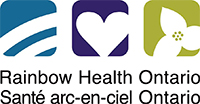 Rainbow Health Ontario (RHO)
Rainbow Health Ontario (RHO)
Provides training to service providers about LGBTQ health; shares information, resources and research; consults on public policy issues; and works with organizations to build capacity.
 Sherbourne Health Centre
Sherbourne Health Centre
Located in Toronto and a member of Rainbow Health Ontario, Sherbourne serves LGBT, Homeless and Under-housed, Newcomers and Mid-East Toronto residents and offers counselling, parenting and family programs, youth health and monitoring, and Trans health care.
Resources
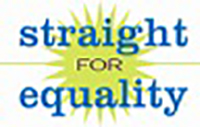 1. For Allies
1. For Allies
This guide educates and empowers “straight” people to support and advocate for LGBT equality at home, work and in the community.
2. For Trainers
Training for Change: Practical Tools for Intersectional Workshops.
This toolkit provides practical exercises to promote intersectionality and address stereotypes and sexism in LGBT communities.
3. For Aboriginal Peoples
Our Relatives Said: A Wise Practices Guide (2008)
This booklet provides information on traditional roles of Trans-people in the Aboriginal community, and tools and resources to support health providers and organizations in Aboriginal communities.
![]() 4. For Immigrants and Refugees
4. For Immigrants and Refugees
Positive Spaces Initiative
An initiative from OCASI to support agencies and organizations to develop welcoming environments where LGBTQ+ newcomers are able to access services free from discrimination based on sexual orientation, gender identity and gender expression. Positive Spaces offers online assessment tools, a starter kit and access to training programs.
5. For Older Adults
Diversity Our Strength – LGBT Tool Kit for Creating Lesbian, Gay, Bisexual and Transgendered Culturally Competent Care at Toronto Long-Term Care Homes and Services
Developed by Toronto Long-Term Care Homes and Services to assist in establishing cultural competencies in providing care and services for elder LGBT residents, partners and their friends, while also creating a welcoming environment for staff, volunteers, and the local community.
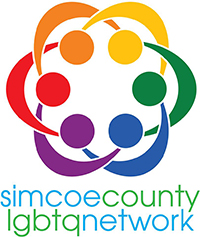 6. For Youth
6. For Youth
Making it Better Today: The Simcoe County LGBT Youth Needs Assessment Report
Key findings from a community consultation in Simcoe County regarding experiences of LGBT youth in the area as well as service needs assessment. 10 Action Steps are offered for those working with LGBT youth.
Sign up for the Learning Network’s Upcoming Webinar:
Partner Violence in Rainbow Communities: What We Know and What We Need to Know
Betty Jo Barrett, MSSW, Ph.D., Associate Professor of Social Work and Women’s Studies, University of Windsor
Since the mid 1980’s, a growing body of literature has examined the existence of intimate partner violence in lesbian, gay, bisexual, transgender, queer, questioning, two spirited, and asexual plus (LGBTQQ2A+) communities. This presentation will provide an overview of current research and theories on partner violence in LGBTQQ2A+ communities. Implications for the continued development of services for LGBTQQ2A+ survivors of partner violence that are LGBTQQ2A+ positive and affirmative will also be explored.
Date: Thursday, June 11, 2015 | 10:00am to 11:00am EST
Just Released:
Intimate Partner Violence in Rainbow Communities
A Discussion Paper Informed by the Learning Network Knowledge Exchange, November 2014
This Learning Network resource on IPV in rainbow communities includes comments from key stakeholders, information from the literature; descriptions of how IPV may be experienced; the consequences and barriers to understanding, disclosing and seeking help; and considerations for continuing to move forward. A glossary, links to key organizations and networks, and links to toolkits are included.
The Learning Network Team is grateful for the valuable contributions from the reviewers of this Newsletter:
Sly Castaldi, Board of Directors, Ontario Coalition of Rape Crisis Centres
Marlene Ham, Coordinatior, Simcoe County LGBTQ Network
Marsha Sfeir, Executive Director, Springtide Resources
Written by the Learning Network Team:
Linda Baker, Learning Director
Anna-Lee Straatman, Research Associate
Nicole Etherington, Research Associate
Elsa Barreto, Graphic Design
Please evaluate us!!!
Let us know what you think. Your input is important to us. Please complete this brief survey on your thoughts of this newsletter: https://uwo.eu.qualtrics.com/jfe/form/SV_3qp8ixEOK0y2fOd
Footnotes:
Krizsan, A. & Lombardo, E. (2013). The quality of gender equality policies: A discursive approach. European Journal of Women’s Studies, 20(1), 77-92.
Lindhorst, T., Mehrotra, G., & Mincer, S.L. (2010). Outing the abuse: Considerations for effective practice with lesbian, gay, bisexual, and transgender survivors of intimate partner violence. In L.L. Lockhart & F.S. Danis (Eds.), Domestic Violence: Intersectionality and culturally competent practice (pp. 232-267). New York: Columbia University Press.
Bograd, M. (1999). Strengthening domestic violence theories: Intersections of race, class, sexual orientation and gender. Journal of Marital and Family Therapy, 25(3), 275-289.





